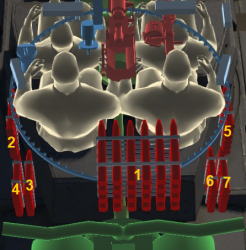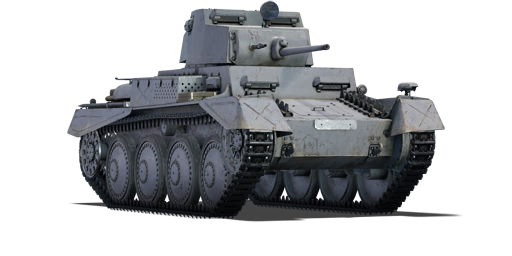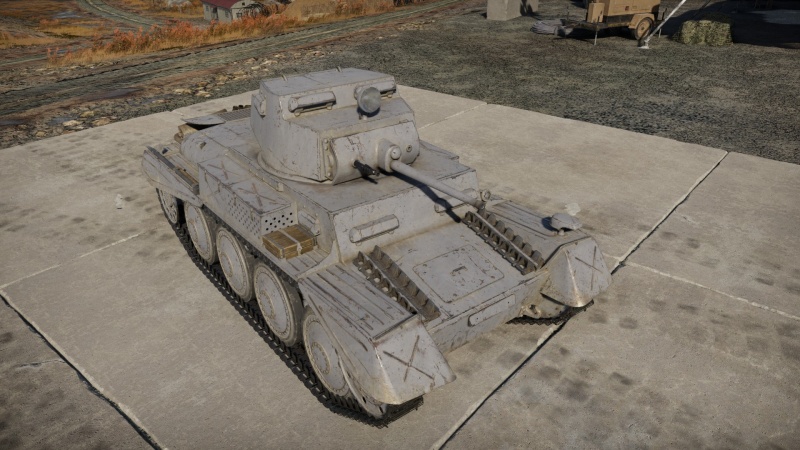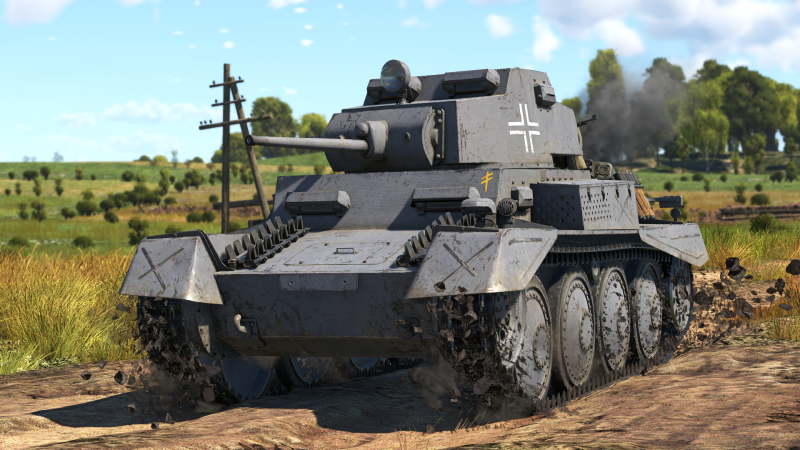Pz.38(t) n.A.
| This page is about the German light tank Pz.38(t) n.A.. For other versions, see Pz.38(t) A and Pz.38(t) F. |
Contents
Description
The Pz.38(t) n.A. is a rank I German light tank with a battle rating of 2.3 (AB/RB/SB). It was introduced in Update "La Royale".
General info
Survivability and armour
While armour isn't very favourable on the Pz.38(t) n.A. compared to the Pz.38(t) F at the same BR, it makes that in less weight and a better engine, allowing it to get into more favourable positions quicker; be it finding a good sniping/ambush spot or driving out an incoming shell.
Armour type:
- Rolled homogeneous armour
- Cast homogeneous armour (gun manlet)
| Armour | Front (Slope angle) | Sides | Rear | Roof |
|---|---|---|---|---|
| Hull | 30 mm (20º) Front plate
20 mm (75º) Upper glacis 30 mm (15º) Lower glacis |
25 mm | 20 mm (5º) | 10 - 20 mm |
| Turret | 30 mm (6º) Turret front 50 mm (5-38º) Gun mantlet |
12 - 25 mm | 20 mm (12º) | 12 mm (83º) |
| Cupola | 20 mm (25º) | 25 mm (9º) | 20 mm (23º) | 12 mm |
Notes:
- Two tracks on the upper glacis provide an additional 7.5 mm of protection.
Mobility
Write about the mobility of the ground vehicle. Estimate the specific power and manoeuvrability, as well as the maximum speed forwards and backwards.
| Game Mode | Max Speed (km/h) | Weight (tons) | Engine power (horsepower) | Power-to-weight ratio (hp/ton) | |||
|---|---|---|---|---|---|---|---|
| Forward | Reverse | Stock | Upgraded | Stock | Upgraded | ||
| Arcade | 68 | 10 | 11.5 | 341 | 420 | 29.65 | 36.52 |
| Realistic | 61 | 9 | 195 | 220 | 16.96 | 19.13 | |
Modifications and economy
Armaments
Main armament
| 37 mm KwK38(t) | Turret rotation speed (°/s) | Reloading rate (seconds) | |||||||||||
|---|---|---|---|---|---|---|---|---|---|---|---|---|---|
| Mode | Capacity | Vertical | Horizontal | Stabilizer | Stock | Upgraded | Full | Expert | Aced | Stock | Full | Expert | Aced |
| Arcade | 60 | -10°/+25° | ±180° | Shoulder | 13.3 | 18.4 | 22.4 | 24.8 | 26.4 | 4.29 | 3.80 | 3.50 | 3.30 |
| Realistic | 8.3 | 9.8 | 11.9 | 13.2 | 14.0 | ||||||||
Ammunition
| Penetration statistics | |||||||
|---|---|---|---|---|---|---|---|
| Ammunition | Type of warhead |
Penetration @ 0° Angle of Attack (mm) | |||||
| 10 m | 100 m | 500 m | 1,000 m | 1,500 m | 2,000 m | ||
| Pzgr. 34(t) | APC | 62 | 59 | 45 | 32 | 23 | 17 |
| PzGr. 40 | APCR | 86 | 77 | 47 | 26 | 14 | 8 |
| Pzgr.(t) umg. | APC | 61 | 58 | 44 | 31 | 22 | 15 |
| Shell details | ||||||||||||
|---|---|---|---|---|---|---|---|---|---|---|---|---|
| Ammunition | Type of warhead |
Velocity (m/s) |
Projectile mass (kg) |
Fuse delay (m) |
Fuse sensitivity (mm) |
Explosive mass (TNT equivalent) (g) |
Ricochet | |||||
| 0% | 50% | 100% | ||||||||||
| Pzgr. 34(t) | APC | 741 | 0.85 | 1.2 | 9 | 22.1 | 48° | 63° | 71° | |||
| PzGr. 40 | APCR | 1,020 | 0.37 | - | - | - | 66° | 70° | 72° | |||
| Pzgr.(t) umg. | APC | 750 | 0.82 | 1.2 | 9 | 22.1 | 48° | 63° | 71° | |||
Ammo racks

| Full ammo |
1st rack empty |
2nd rack empty |
3rd rack empty |
4th rack empty |
5th rack empty |
6th rack empty |
7th rack empty |
Visual discrepancy |
|---|---|---|---|---|---|---|---|---|
| 60 | 37 (+23) | 31 (+29) | 25 (+35) | 19 (+41) | 13 (+47) | 7 (+53) | 1 (+59) | No |
Machine guns
The small calibre of the MG34 machine gun makes it largely ineffective against all armoured vehicles but the ones with an open compartment.
| 7.92 mm MG34 | ||||
|---|---|---|---|---|
| Mount | Capacity (Belt) | Fire rate | Vertical | Horizontal |
| Coaxial | 2,100 (150) | 900 | - | - |
Usage in battles
Describe the tactics of playing in the vehicle, the features of using vehicles in the team and advice on tactics. Refrain from creating a "guide" - do not impose a single point of view but instead give the reader food for thought. Describe the most dangerous enemies and give recommendations on fighting them. If necessary, note the specifics of the game in different modes (AB, RB, SB).
Pros and cons
Pros:
- Shoulder stabilizer
Cons:
- Somewhat weak gun at its BR
History
By 1942, action in Operation Barbarossa had seen the Pz.38(t) lose its capability as a regular tank, instead preforming reconnaissance missions, but production capacity for Pz.38(t) chassis still remained. As a solution Pz.38(t) n.A., which stood for Neuer Art, was a proposed modernized version of the Pz.38(t), but was rejected and Pz.38(t) chassis were instead used to build other vehicles such as the Marder III and Hetzer.
Devblog
Experimental light tank Pz.Kpfw.38 (t) n.A. was developed in 1941 by the Czech company BMM to participate in the reconnaissance tank contest for the German army. The tank was built on the chassis of the light Czechoslovak tank LT vz.38 and was distinguished by a more powerful gun, a new 8-cylinder engine, bigger wheels and wider tracks. Despite the best results in mobility trials, the tank was denied mass production due to high fuel consumption, a cramped turret and a 37 mm gun, which was considered excessive. Developments under the program Pz.Kpfw.38 (t) n.A. were further developed into light tank destroyer Jagdpanzer 38(t), also known as the Hetzer.
Media
- Skins
- Videos
See also
- Related development
External links
| Germany light tanks | |
|---|---|
| Pz.II | Pz.II C · Pz.II C (DAK) · Pz.II C TD · Pz.II F · Pz.Sfl.Ic |
| Sd.Kfz.234 | Sd.Kfz.234/1 · Sd.Kfz.234/2 · Sd.Kfz.234/2 TD |
| Marder | Marder A1- · Marder 1A3 · Begleitpanzer 57 · DF105 |
| PUMA | |
| Wheeled | Sd.Kfz.221 (s.Pz.B.41) · Class 3 (P) · Radkampfwagen 90 |
| Other | Ru 251 · SPz 12-3 LGS |
| Argentina | TAM · TAM 2C · TAM 2IP · JaPz.K A2 |
| Czechoslovakia | Pz.35(t) · Pz.38(t) A · Pz.38(t) F · Pz.38(t) n.A. · Sd.Kfz. 140/1 |
| France | Pz.Sp.Wg.P204(f) KwK |
| Lithuania | Vilkas |
| USA | leKPz M41 |
| USSR | SPz BMP-1 |






